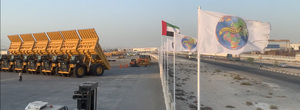More from Element8 Web Design
More in Politics
Related Blogs
Archives
Social Share
Safety Considerations When Buying Used Construction Equipment
Body
1. Equipment Inspection
Before making any purchase, it's essential to thoroughly inspect the used construction equipment. Look for signs of wear and tear, rust, or damage that could compromise safety. Pay close attention to critical components such as hydraulic systems, brakes, tires, and structural integrity. If possible, hire a qualified mechanic or technician to inspect the equipment to ensure it meets safety standards.
2. Maintenance Records
Request maintenance records for the equipment you're considering. A well-maintained machine is less likely to have safety issues. These records can give you insight into how the equipment has been cared for over its lifetime. Regular maintenance is crucial for keeping construction machinery in safe working condition.
3. Age and Usage
Consider the age and usage history of the equipment. Older machines may not meet current safety standards or may lack modern safety features. Additionally, heavily used equipment may be more prone to breakdowns or failures, which can pose safety risks on the job site. Be cautious when buying equipment with a significant number of operating hours.
4. Safety Features
Evaluate whether the used construction equipment has essential safety features. Newer models often come equipped with advanced safety technology, such as rollover protection systems (ROPS), falling object protection systems (FOPS), backup cameras, and proximity sensors. These features can enhance worker safety and reduce the risk of accidents.
5. Certification and Compliance
Ensure that the equipment meets industry safety standards and regulations. Look for certification labels or markings that indicate compliance with safety guidelines. Depending on your location, there may be specific safety requirements that construction equipment must meet. Verify that the equipment adheres to these regulations.
6. Operator Training
Consider the training and experience of your equipment operators. Ensure that they are adequately trained to operate the specific machinery you plan to purchase. If the equipment is significantly different from what your operators are familiar with, additional training may be necessary to maintain safe operation.
7. Warranty and Support
Check if the seller offers a warranty or support for the used equipment. A warranty can provide peace of mind and financial protection in case the equipment experiences unexpected issues related to safety. Having access to manufacturer support or spare parts can also be valuable in maintaining safety and uptime.
8. Price vs. Safety
While cost savings are a significant consideration when buying used construction equipment, it's essential not to compromise safety for a lower price. Cutting corners on safety can lead to accidents, injuries, and costly downtime. Balance your budget constraints with your commitment to safety.
9. Ongoing Safety Inspections
After purchasing used construction equipment, establish a routine schedule for safety inspections and maintenance. Regularly check for wear and tear, replace worn-out parts, and address any safety concerns promptly. Preventative maintenance can extend the lifespan of the equipment and ensure continued safe operation.
Conclusion
Safety should always be a top priority when purchasing used construction equipment. By following these safety considerations, you can make informed decisions that protect your workers and ensure the longevity and reliability of your machinery. Remember that a well-maintained and safe work environment leads to increased productivity and reduced risks, benefiting both your business and your employees.











Comments